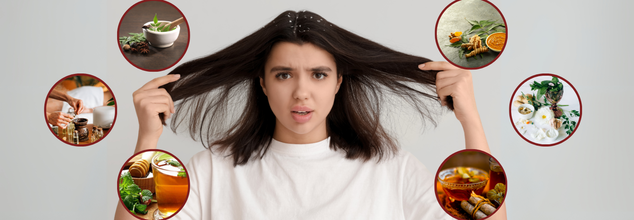
Image Credits: Canva
Better Than Green Tea? The Herbal Infusions That Naturally Balance Blood Sugar
Living with diabetes isn’t just about cutting sugar—it’s about understanding and making daily choices with intention. People with diabetes have always felt a sense of overwhelming emotions while checking food and drinks labels and wondering how to best control the next spike your blood sugar. Managing diabetes is like learning a new language—of balance, patience, and smart habits. It’s not just about medication; it's about your morning walks, the herbal tea you choose, and even how you manage stress.
For millions living the struggles of blood sugar management, every dietary choice matters. Among the simple yet effective changes catching on across the world is rethinking the daily cup of tea. Whereas traditional tea—in the forms of black, green, or oolong—is a longtime member of wellness talk, herbal teas are starting to appear as more gentle, but equally effective, options in seeking blood sugar harmony. But how do they differ? And can a relaxing herbal mixture actually affect blood glucose levels? Let's get into the science and ancient wisdom surrounding these potables.
At first glance, the term "tea" is usually synonymous with any hot, leaf- or herb-brewed beverage. But from a botanical perspective, there is a clear distinction.
All real teas—black, green, oolong, white, and pu-erh—are made from the same plant, Camellia sinensis. The difference is in processing: black is fully oxidized, green is lightly processed, and oolong is in between. They all have caffeine and varying amounts of antioxidants called polyphenols.
In comparison, herbal infusions—also referred to as tisanes—are made by infusing a wide variety of herbs, flowers, roots, fruits, and spices. They are stimulant-free, which is already an advantage for those who are sensitive to stimulants. Consider chamomile, hibiscus, lemongrass, and mint—their therapeutic potential comes from the distinct bioactive compounds they have.
How Tea Helps Manage Blood Sugar Levels?
Various research has examined tea's health properties, especially of green and black teas. Highly concentrated with polyphenols and catechins, these two teas demonstrate promising potential to normalize blood glucose and enhance insulin sensitivity.
A 2021 scientific review emphasized that green tea polyphenols may provide protective benefits against autoimmune disorders such as type 1 diabetes and lower cardiovascular disease and metabolic syndrome risk. Likewise, black tea has also promised benefits towards cardiovascular health and glucose absorption modulation to ensure more stable energy levels and lesser post-meal glucose spikes.
However, there’s a caveat. Most traditional teas come with caffeine, a stimulant that can elevate stress hormones such as cortisol. For individuals with diabetes or insulin resistance, increased stress can worsen blood sugar control. Moreover, the habit of adding sugar, honey, or milk to tea can unintentionally spike glucose levels—countering any potential benefits.
As Dr. Rohit Sane, an expert in Ayurveda, suggests, "Making the move from your regular cup of tea to herbal infusions may be the subtle but potent shift your body is craving."
These caffeine-free herbal blends are commonly formulated using herbs that are renowned for their anti-inflammatory, antioxidant, and adaptogenic qualities—a combination that promotes improved metabolic well-being.
Three top herbs in Ayurvedic infusions are:
1. Gudmar (Gymnema sylvestre)
Commonly known as the "sugar destroyer," Gudmar is a key player in suppressing sugar cravings and improving insulin sensitivity. By enhancing the way your body metabolizes sugar, it is a powerful friend for those who experience constant glucose spikes.
2. Tulsi (Holy Basil)
Revered as a sacred plant in India, Tulsi is more than just a stress reliever. Its adaptogenic properties help the body cope with physical and emotional stress—a crucial aspect since stress is often an invisible driver of fluctuating blood sugar levels. Tulsi’s gentle nurturing effect on the nervous system supports overall balance.
3. Cinnamon
One of the staples of the pantry spice, Cinnamon has more than flavor to offer. It acts like insulin, assists glucose metabolism, and facilitates moving sugar from the blood into cells even better. It's a sweet fix that doesn't add sugar.
Dr. Sane continues, "Changing to herbal infusions is all about respecting your body. Each cup is a moment of peace, a ritual of recovery."
Tips to Drink Herbal Infusions for Diabetes Management
Though herbal infusions seem the ideal answer, there are some things to remember. Steer clear of pre-packaged or flavored teas with sugar added, and always check ingredient labels. Unsweetened infusions are the way to go, as honey or sugar, even natural sugars, can negate the benefits.
Also, talk with your doctor if you are on medication for diabetes. Certain herbs, like prickly pear, may interact with medications like metformin or glipizide and boost their effects.
To make your tea healthy, instead of using sweetners, try having lemon wedges, fresh mint, or even a cinnamon stick. The intent is to care for your well-being, not ruin it unexpectedly.
Blood sugar control isn't so much about discovering a miracle cure; it's about making responsible, long-term lifestyle decisions. Adding herbal infusions to your daily regimen is one of those decisions. They offer hydration, medicinal benefits, and a mindful moment—considerations that cumulatively lend themselves to overall well-being.

(Credit-Canva)
Can You Get Rid Of Dandruff Naturally? Ayurvedic Remedies To Boost Scalp Health
Dandruff may get worse with winters, but for many it is an all year-round issue. It makes your scalp feel itchy, flaky as well as irritating. While one may think that this isn’t a big deal as it is just in our scalp, often they can create a flaky mess, showing up on clothes and may cause people to feel self-conscious. There are many ways to tackle this issue, there are dedicated shampoos, conditioners and treatments that can help you get rid of dandruff. However to do it properly, one must understand what dandruff actually is and the causes of it as well.
What is Dandruff and What Causes It?
According to Mayo clinic Dandruff happens when small pieces of dry skin flake off your scalp, often because your scalp is producing too much oil. As old skin cells die and new ones replace them, the old cells are pushed to the surface and flake off. This can make your scalp feel dry, rough, itchy, and sometimes even red. When dandruff is severe, skin cells might multiply faster, leading to more noticeable flakes and constant itching.
Several things can contribute to dandruff. Not washing your hair often enough can make it worse because oil, dirt, dead skin cells, and product buildup accumulate on your scalp. Also, your scalp can get irritated by chemicals in hair care products, causing an itchy rash. Dry skin, especially in winter when the air is less humid, can also lead to dandruff with smaller, less oily flakes. Hormones can also play a role, as they can increase oil production on the scalp, making dandruff more common in some people.
Here Are Some Ayurvedic Tips That Can Help
Bhringraj
This herb, often called the 'King of Herbs', is traditionally used to promote strong and healthy hair growth. It is also thought to help prevent hair from turning gray too early, while its properties can soothe an irritated scalp and reduce dandruff flakes by improving circulation.
Shikakai
Revered as the 'Fruit of the Hair', Shikakai is a natural cleanser that has been used for centuries. It gently removes dirt and excess oil from the scalp without stripping away its natural moisture, which can help manage dandruff and promote a healthier scalp environment for hair growth.
Neem
Widely recognized as a potent healer in traditional practices, Neem possesses strong antifungal properties that can effectively combat the fungi often associated with dandruff. It is also known for its ability to calm inflammation and reduce the persistent itching and irritation of the scalp caused by dandruff.
Tea Tree
The oil extracted from the Tea Tree is well-known for its powerful antimicrobial properties, making it a valuable ingredient in addressing dandruff. It can help to fight the microorganisms that contribute to a flaky scalp and reduce the overall severity of dandruff symptoms like itching and visible flakes.
Here are some other home remedies you can try with easily available household items and herbs.
- Soak Neem leaves overnight, make a paste with yogurt, apply for 30 mins.
- Mix egg whites with lemon juice as a hair mask.
- Gently massage baking soda into wet hair as a scrub.
- Combine Amla powder with Tulsi leaf paste, apply to scalp.
- Soak and grind Fenugreek seeds with lemon juice, apply as a paste.
- Mix Apple Cider Vinegar with water, apply to scalp.
- Soak Reetha, Shikakai, and Amla overnight, boil, strain, and use as shampoo.
- Pound Garlic with water, honey, and ginger powder, apply to scalp.
- Mix Tea Tree Oil with coconut oil, apply to scalp.

Credit: Canva
Eye Health Is Connected To Pitta Dosha—Ayurvedic Herbs That Boost Eyesight
In Ayurveda, the health of our eyes is deeply rooted in the balance of elemental forces.
Ayurvedic experts state that the body is made up of five fundamental elements (Tatvas)—Earth (Prithvi), Water (Jala), Fire (Agni), Air (Vayu), and Ether (Akasha). These elements form the foundation of the three biological energies (doshas)—Vata, Pitta, and Kapha—that govern various physiological functions.
Eyes Are Linked To Pitta Dosha
Pitta dosha, associated with the fire element, is responsible for metabolism, transformation, and heat regulation in the body. Ayurveda considers the eyes to be Pitta's primary seat. As such, prolonged exposure to harsh sunlight, UV rays, and digital screens can aggravate Pitta, leading to symptoms such as burning, redness, dryness, and inflammation in the eyes.
Here Are Ayurvedic Herbs For Eye Health
Triphala, a well-known Ayurvedic formulation made from Amalaki, Bibhitaki, and Haritaki, is highly recommended for eye care. It has cleansing and rejuvenating properties that help maintain clear vision. A Triphala eyewash can soothe irritated eyes and promote ocular health.
Yashtimadhu, or licorice root, revered for its anti-inflammatory and cooling effects, is another herb beneficial for reducing redness and irritation, especially due to UV exposure. Similarly, Ashwagandha—a potent adaptogen—can help alleviate stress and inflammation in the body, including in the eyes. “It is beneficial for maintaining overall eye health and combating the effects of UV rays,” says Dr. Mandeep Singh Basu, director of Dr. Basu Eye Hospital and Jagat Pharma.
Ghee, or clarified butter, is known in Ayurveda for its nourishing and cooling effects. Applying a few drops to the eyes at bedtime can relieve dryness and inflammation. A blend of honey and turmeric can also serve as an antimicrobial and anti-inflammatory eye drop, offering protection against infections caused by sun damage.
Other natural remedies include fennel seeds (saunf), which have soothing properties and can be used as tea or an eyewash. Coriander seeds, when boiled and cooled, can also be used to calm inflammation. Saffron, known for its antioxidant content, supports vision and protects against oxidative stress when consumed in warm milk.
Incorporating cooling agents like rose water or cucumber slices helps relieve eye strain, puffiness, and heat. Aloe vera gel, applied around the eyes, also provides a soothing effect.
Herbs such as Ginkgo biloba, chamomile, rosemary, and carrot seed oil are equally beneficial. Ginkgo improves blood circulation to the eyes, chamomile and rosemary reduce inflammation, and carrot seed oil, rich in beta-carotene, supports retinal health and vision.
With increasing exposure to screens and environmental stressors, these Ayurvedic remedies provide a holistic and gentle approach to eye care, helping to preserve one’s vision naturally while keeping the Pitta dosha in balance.

Credit: Canva
Ayurvedic Foods That Naturally Unclog Arteries
Imagine a silent enemy slowly narrowing the roads inside your body, making it harder for your heart to pump blood. That’s what clogged arteries do—putting you at risk of heart disease, strokes, and high blood pressure. But what if nature had already provided us with powerful tools to fight back? Ayurveda, India’s ancient system of medicine, offers time-tested foods that may help keep your arteries clear and your heart healthy.
Here’s a look at some of the best Ayurvedic remedies for arterial health.
1. Triphala: The Detoxifying Trio
Triphala, a blend of three potent fruits—Amla, Bibhitaki, and Haritaki—is known for its detoxifying properties. This combination works like a natural cleanser, helping remove toxins, reduce cholesterol buildup, and improve blood circulation. Studies suggest that its antioxidant-rich profile fights oxidative stress, a major contributor to plaque formation in arteries.
2. Garlic: The Natural Blood Thinner
A simple kitchen ingredient with remarkable health benefits, garlic is revered in Ayurveda for its ability to improve heart health. It contains allicin, a compound known to lower bad cholesterol (LDL) and prevent arterial plaque formation. Regular consumption of raw garlic or its extracts may help in reducing blood pressure and improving overall circulation.
3. Turmeric: The Golden Healer
Turmeric is famous for its anti-inflammatory and antioxidant properties, thanks to curcumin, its active compound. Research suggests that curcumin can reduce fatty deposits in the arteries and improve endothelial function (the lining of blood vessels), keeping them flexible and free from blockages. Adding a pinch of turmeric to warm milk or tea can be a simple yet effective way to support heart health.
4. Arjuna Bark: Ayurveda’s Heart Tonic
Arjuna bark has been used for centuries as a natural heart protector. Rich in antioxidants and flavonoids, it strengthens the heart muscles, regulates blood pressure, and prevents plaque buildup in arteries. Traditionally, Arjuna bark is boiled into a decoction or taken as a supplement to support cardiovascular function.
5. Ginger: The Blood Circulation Booster
Ginger is another household ingredient that works wonders for arterial health. It contains gingerol, a bioactive compound that helps reduce inflammation and lower cholesterol levels. Regular consumption of ginger tea or raw ginger may prevent fat from accumulating in the arteries, improving overall heart health.
6. Ashwagandha: The Stress Reliever
Chronic stress can contribute to high cholesterol and hypertension, worsening arterial blockages. Ashwagandha, an adaptogenic herb, helps reduce cortisol levels (the stress hormone), indirectly supporting heart health. It also improves circulation and may lower blood pressure, making it a valuable addition to your routine.
7. Guggul: The Ayurvedic Cholesterol Fighter
Guggul, derived from the resin of the Commiphora mukul tree, has been a staple in Ayurvedic heart care for centuries. It is known to reduce bad cholesterol (LDL) while boosting good cholesterol (HDL). Modern research supports its role in preventing plaque formation and improving lipid metabolism.
© 2024 Bennett, Coleman & Company Limited

